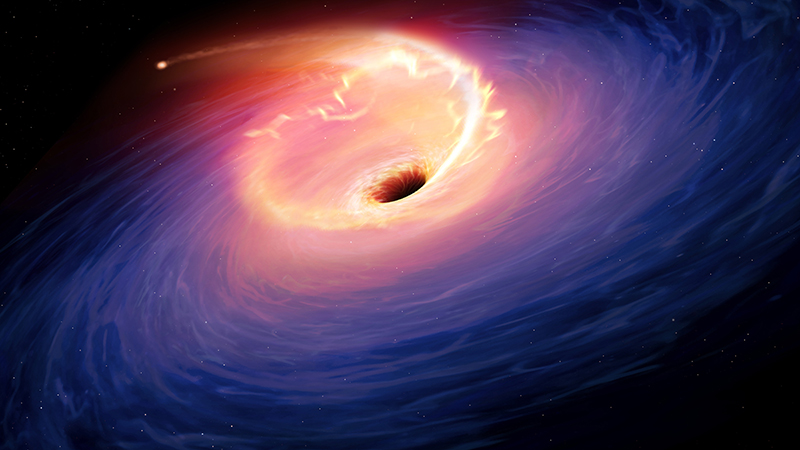Meet 'Scary Barbie,' a black hole slaughtering a star in the brightest way possible
'Scary Barbie' is an incredibly bright cosmic object that has been burning for two years, and it has yet to sputter out.

Astronomers have detected one of the longest, brightest and most energetic cosmic objects ever observed — and they've named it "Scary Barbie," in part due to its terrifying power.
The remote object, an astonishingly bright flash of light that has lasted for more than two years, was discovered lurking inside an enormous data set gathered by computer-guided telescopes.
After finding the brightly burning patch of sky in the data and cross-referencing it with observations made by other telescopes, the astronomers realized they had stumbled across one of the most powerful cosmic explosions ever witnessed. They reported their findings April 17 on the preprint server arXiv, and their paper has been accepted for publication in The Astrophysical Journal Letters.
Related: Black hole 'spaghettified' a star into a doughnut shape, and astronomers captured the gory encounter
"It's absurd. If you take a typical supernova and multiply it a thousand times, we're still not at how bright this is — and supernovas are among the most luminous objects in the sky," co-author Danny Milisavljevic, an assistant professor of physics and astronomy at Purdue University, said in a statement. "This is the most energetic phenomenon I have ever encountered."
Scary Barbie was born from the final death throes of a star being torn to shreds by a supermassive black hole.
Black holes feed upon unfortunate stars that cross their paths, using tidal forces exerted by their immense gravitational pulls. As the star is reeled ever closer to the black hole's maw, the gravity affecting the regions of the star closer to the black hole is far stronger than that acting on the star's farside. This disparity "spaghettifies" the star into a long, noodle-like string that gets tightly wound around the black hole layer by layer — like spaghetti around a fork.
Sign up for the Live Science daily newsletter now
Get the world’s most fascinating discoveries delivered straight to your inbox.
This noodle of hot plasma then quickly accelerates around the black hole and spins out into an enormous jet of energy and matter, which produces a distinctive bright beam of light — known as a transient event — that optical, X-ray and radio-wave telescopes can detect.
Because Scary Barbie's light came from a remote region of the sky — traveling around 7.7 billion years across the expanding fabric of space-time — astronomers didn't spot the event directly. Instead, by developing a machine-learning system called Recommender Engine For Intelligent Transient Tracking, the researchers combed through data from many observations before finding the extremely bright light source. By using the Lick Observatory in California and the Keck Observatory in Hawaii, the researchers were better able to characterize the light as coming from a transient event.
But Scary Barbie — a nickname made by appending its randomly assigned alphanumeric name, ZTF20abrbeie, with a reference to its frightening power — is weird even among other rare and extreme astronomical events. It is much brighter than any other transient event the astronomers could compare it to, and, while transient events usually last only weeks or months, Scary Barbie has already burned incandescently for more than two years, with no indication it will sputter out.
The astronomers said further observations of Scary Barbie, possibly using the Hubble Space Telescope and the James Webb Space Telescope, could enable them to snap some high-resolution images of the incredibly rare cosmic outburst.
"There are few things in the universe that can be so powerful, reactions that can be this long-lived," Milisavljevic said. "Discoveries like this really open our eyes to the fact that we are still uncovering mysteries and exploring wonders in the universe — things no one has ever seen before."

Ben Turner is a U.K. based staff writer at Live Science. He covers physics and astronomy, among other topics like tech and climate change. He graduated from University College London with a degree in particle physics before training as a journalist. When he's not writing, Ben enjoys reading literature, playing the guitar and embarrassing himself with chess.









